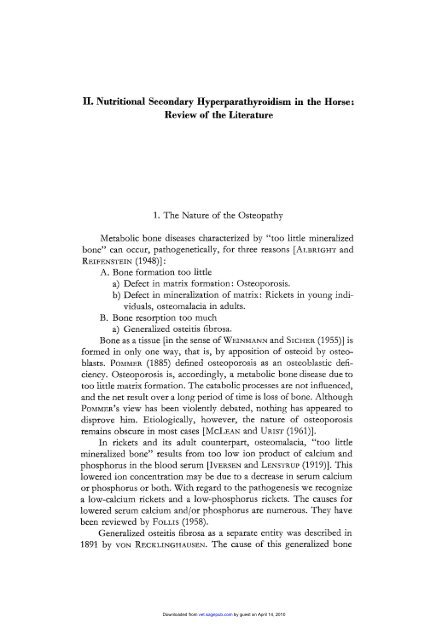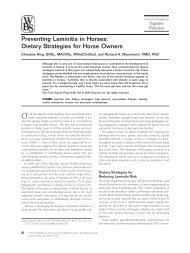Nutritional Secondary Hyperparathyroidism in the Horse
Nutritional Secondary Hyperparathyroidism in the Horse
Nutritional Secondary Hyperparathyroidism in the Horse
Create successful ePaper yourself
Turn your PDF publications into a flip-book with our unique Google optimized e-Paper software.
11. <strong>Nutritional</strong> <strong>Secondary</strong> <strong>Hyperparathyroidism</strong> <strong>in</strong> <strong>the</strong> <strong>Horse</strong> :<br />
Review of <strong>the</strong> Literature<br />
1. The Nature of <strong>the</strong> Osteopathy<br />
Metabolic bone diseases characterized by “too little m<strong>in</strong>eralized<br />
bone” can occur, pathogenetically, for three reasons [ALBRIGHT and<br />
REIFENSTEIN (1948)] :<br />
A. Bone formation too little<br />
a) Defect <strong>in</strong> matrix formation: Osteoporosis.<br />
b) Defect <strong>in</strong> m<strong>in</strong>eralization of matrix: Rickets <strong>in</strong> young <strong>in</strong>dividuals,<br />
osteomalacia <strong>in</strong> adults.<br />
B. Bone resorption too much<br />
a) Generalized osteitis fibrosa.<br />
Bone as a tissue [<strong>in</strong> <strong>the</strong> sense of WEINMANN and SICHER (1955)] is<br />
formed <strong>in</strong> only one way, that is, by apposition of osteoid by osteoblasts.<br />
POMMER (1885) def<strong>in</strong>ed osteoporosis as an osteoblastic deficiency.<br />
Osteoporosis is, accord<strong>in</strong>gly, a metabolic bone disease due to<br />
too little matrix formation. The catabolic processes are not <strong>in</strong>fluenced,<br />
and <strong>the</strong> net result over a long period of time is loss of bone. Although<br />
POMMER’S view has been violently debated, noth<strong>in</strong>g has appeared to<br />
disprove him. Etiologically, however, <strong>the</strong> nature of osteoporosis<br />
rema<strong>in</strong>s obscure <strong>in</strong> most cases [MCLEAN and URIST (1961)].<br />
In rickets and its adult counterpart, osteomalacia, “too little<br />
m<strong>in</strong>eralized bone” results from too low ion product of calcium and<br />
phosphorus <strong>in</strong> <strong>the</strong> blood serum [IVERSEN and LENSTRUP (1919)l. This<br />
lowered ion concentration may be due to a decrease <strong>in</strong> serum calcium<br />
or phosphorus or both. With regard to <strong>the</strong> pathogenesis we recognize<br />
a low-calcium rickets and a low-phosphorus rickets. The causes for<br />
lowered serum calcium and/or phosphorus are numerous. They have<br />
been reviewed by FOLLIS (1958).<br />
Generalized osteitis fibrosa as a separate entity was described <strong>in</strong><br />
1891 by VON RECKLINGHAUSEN. The cause of this generalized bone<br />
Downloaded from<br />
vet.sagepub.com by guest on April 14, 2010



